Thursday This morning we went by the bakery and picked up some bread and cookies on our way out of town. They had several types of white breads, such as loaves, rolls, cheese topped, etc. It is nice to have some bread choices. In most places in French Polynesia your only choice was a baguette, though occasionally we would find coconut bread. The bread was really good. Cookies were not.
We had decided to head south, figuring that Matapa would be our last stop of the day. The first stop on the southern route was Ana Ana lookout point. There was a short staircase leading to an extremely jagged coral ledge. We know this island is coral and limestone, but we were shocked to see that this ledge was definitely made out of coral. No doubt about it. It amazed us that at some point in time this 100 foot lookout was completely underwater and an abundant reef thriving with life. We later found out that the island had eroded into being basically just a reef and some tectonic activity somehow caused the island to rise up again from the bottom up, and suddenly the existing reef was the top of the island and a new reef formed at the bottom. Now we are wondering if what we had thought was lava rock on some of the other islands was also been dead coral that had somehow managed to surface. It is hard to believe that all the foliage on this island lives in this hostile appearing rock.
We clambered carefully over the sharp coral to the edge of the cliff. The wind was strong and the seas were rough. The waves smacked violently against the cliffs below, shooting sea spray high up in the air. It was really a neat view.
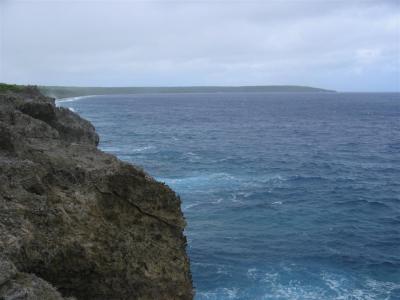
The next stop was the Matavai resort, the swanky resort on the island. It was a nice hotel, but hotels don’t interest us much. They had a poster hanging in the lobby about Coconut Crabs, which they call Uga. Uga are still allowed to be caught here, but there are strict rules about releasing them if they are small in size or in a reproductive stage. The poster showed pictures of how to tell the ones you can keep. It described the life cycle of Uga. The adults are sexually mature at six years old. They mate and the female carries the eggs for six months. The mother hangs her rear end over a cliff and drops the eggs 100 feet into the ocean below. The eggs disperse and hatch. The babies grow for a couple months in the water, and then pick up small shells to live in as they go to land. They make their way into the forest and at six months grow their own shells. Each time they grow, they bury themselves for a month while they shed the old shell and form the new one. They grow from one to three times a year. They live to be 50.
The next stop was Avatele beach. We had been told Niue had no beaches, so we were surprised there was a beach. There was even a road down there. We drove the car down the hill and found a boat ramp at the bottom and a postage sized area of sand covered with chunks of coral. So much for “the beach”.
We tried to find a deserted fort and scenic lookout at Vaiea. The road that looked like it should go there ended at a cul de sac. We didn’t see a footpath to continue on and we weren’t going to traipse through people’s yards to look for it. Not too much farther down the main road we found a turn off to another dirt road. It was overgrown with bushes. Maybe this was the road, but we were dubious since it wasn’t marked. We drove down it for quite a ways before finally deciding it was a road to nowhere and turning around.
The next stop was Anapala Chasm. We made several attempts to find the turn off. We wound up driving through a school’s grass and found a sign marking the road on the other side of the school. This road was even more overgrown and scary than the last one. It was a long drive. If it weren’t for a couple of signs along the way confirming we were on the right path, we would have probably turned around. We began to wonder if we should have stayed on that last road that seemed to go nowhere. We finally got to the chasm. We had our snorkeling gear, expecting a lovely pool like we had swam in yesterday. We got to the bottom of the steep staircase and were taken aback by the sight below.
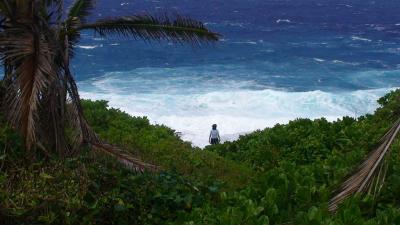
Huge waves were building up at the rock ledge and came crashing down. We could tell the chasm was directly in front of us because the waves on both sides would crash normally against the cliff, sending up big sea spray. Right in front of us, as the crest began to crash down, it would disappear into the hole. You could see the water begin to drain out of the hole just as the next wave peaked. There was so much sea foam it looked like milk, not water. We decided it may be a wee bit rough for a snorkel and headed back out. You can just see the edges of the chasm in the first photo and the second one is the coastline.

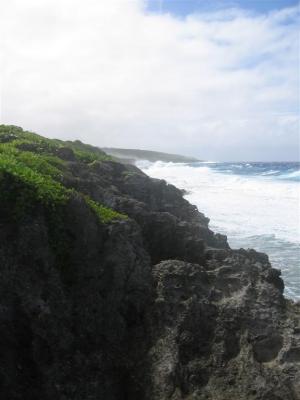
The next stop was Togo, located in the Huvalu Forest Conservation Area. When we first got out of the car, we were in a nice forest. We noticed some coral in and amongst the trees.
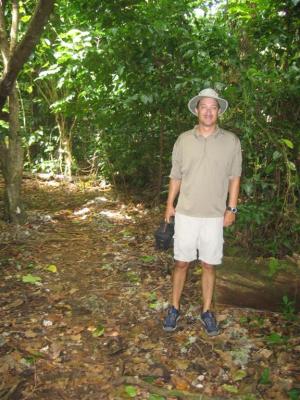
The farther we walked, the larger and denser the coral formations became and the less trees there were. The coral formations all had bushes growing out of them, which was kind of weird looking.
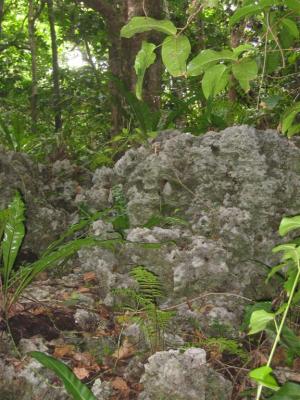
At the edge of the cliff, the trees ended. There was a steep staircase carved into the rock leading down. After going down a ways and turning a couple corners, another ledge came into view that was directly below us. This ledge looked just like a mini Bryce Canyon, but brown with some climbing plants growing in and amongst the peaks.
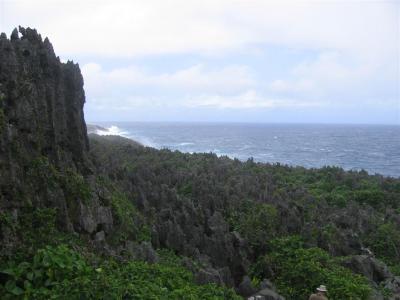
We continued our descent. Even though we were at least 70 feet above the water and at least 20 feet from the edge of the cliff, we were consistently sprayed with a fine mist of sea water from the turbulent ocean below. The path turned sharply to the right. We followed it for another 30 feet or so and came to a ledge. Much to our surprise, there was sand at the bottom of this chasm and SOS NUIE was written in the sand. There was a ladder leaning against the ledge. It was a little intimidating because it looked like a long way down, but it looked much worse than it was.
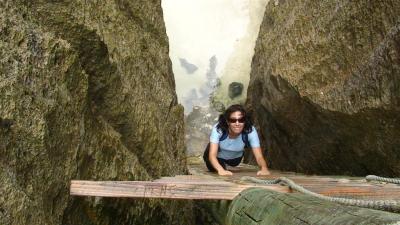
Inside the chasm at the bottom of the ladder was a small, ankle deep pool of water that seeps into the cave from the ocean. The SOS was made out of coconut shells and flip flops, which we found humorous.
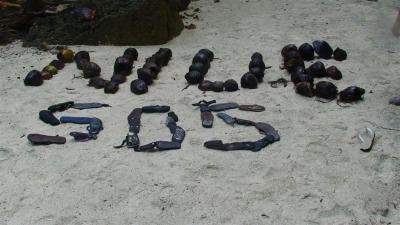
The chasm actually is a 90 degree angle, and when you turn the corner you see huge rocks piled up with big crabs hiding in the rocks. There is no way out of the chasm other than going back up the ladder. It looks like it would be a fun rock climb.
We headed up the ladder and made our way over the jagged, sharp coral to the edge of the cliff. Below us were three large rocks. The waves would crash over the rocks and they would momentarily disappear. The water would start to dissipate, making the rocks momentarily visible before being hidden by another crashing wave. We watched the water for a while. This was the most turbulent spot yet. Then we noticed that two of the rocks were connected by an arch. It was hard to see the arch because the waves were going above and below the arch. Then we noticed the third rock had a large hole in the top that went through to the bottom. Some of the wave would sink into the hole and slowly drain out the bottom, while the water around it would run off the top of the rock. It was a neat sight. We didn’t take any pictures because we didn’t want the cameras to get wet from all the sea spray.
We tried to find another scenic viewpoint at Liku Village, but no luck finding it. It was time to head back. The fish market is open erratic hours based upon when fish comes in. Today it closed at 1600 (4:00 pm), and we wanted to get some fresh fish today since we didn’t know if it would be open tomorrow. We got some cuts of yellowfin, opah (moonfish), and mahi mahi. The fish here is about $4.00 USD per pound. We saw the fishermen unloading the fish at the dock last night, so we know it is really fresh. We dropped the fish off at the boat and headed to the yacht club for a BBQ. They were grilling sausage and fish. The sides were salad and “wedges”. The wedges were a mix of fried taro root, arrowroot and kumala. It was similar to potato wedges and good.

Excellent pics. I just spoke with Adrienne today and in a few weeks I’m going to help her convert her 1000 pictures into a nice divx video. I’ll post when it’s up on stage6.